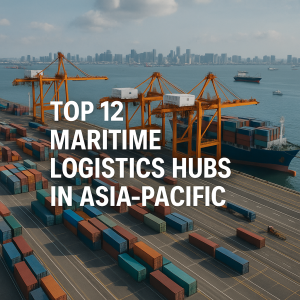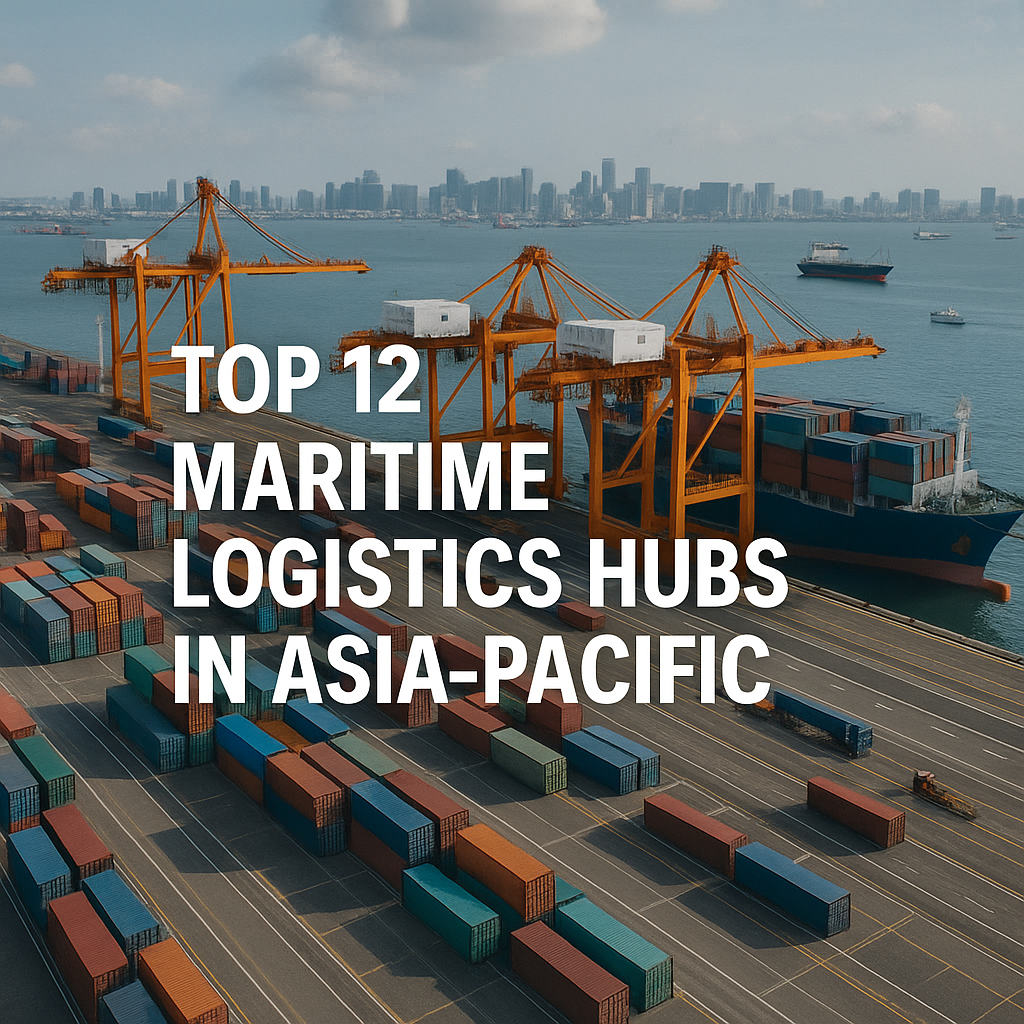 In the complex web of global trade, maritime logistics hubs in the Asia-Pacific region stand as the vital arteries that keep commerce flowing between continents. These hubs are not just ports — they are ecosystems of innovation, infrastructure, and intermodal connections. Whether you’re a maritime student, logistics professional, or shipping enthusiast, understanding these hubs helps explain how goods move, how global trade evolves, and how ports adapt to 21st-century challenges.
In the complex web of global trade, maritime logistics hubs in the Asia-Pacific region stand as the vital arteries that keep commerce flowing between continents. These hubs are not just ports — they are ecosystems of innovation, infrastructure, and intermodal connections. Whether you’re a maritime student, logistics professional, or shipping enthusiast, understanding these hubs helps explain how goods move, how global trade evolves, and how ports adapt to 21st-century challenges.
This article explores the Top 12 maritime logistics hubs in Asia-Pacific — highlighting what makes them competitive, how they are changing with technology and sustainability, and what lessons they offer for the future of maritime logistics.
Why Maritime Logistics Hubs Matter in the Asia-Pacific
Asia is the beating heart of global trade. The region handles more than half of the world’s container throughput and continues to drive manufacturing and export growth. Within this vast system, maritime logistics hubs act as critical junctions — connecting global shipping routes with inland transport networks and value-added services.
These hubs determine how efficiently goods move between continents. When ports perform well, freight costs drop, turnaround times shorten, and industries flourish. When they falter, congestion spreads across global supply chains. For Asia-Pacific — where distances are vast and production networks are deeply interlinked — efficient hubs are not just important; they are essential.
Criteria for the Top 12 Hubs
A port qualifies as a true maritime logistics hub when it meets several key criteria:
- High container throughput and tonnage
- Strategic geolocation along major global shipping routes
- Excellent hinterland connectivity (rail, road, and inland waterways)
- Advanced port infrastructure and digital systems
- Diversified logistics services, including warehousing and free trade zones
- Ongoing investments in modernization, automation, and sustainability
With these benchmarks in mind, let’s explore the twelve most influential maritime logistics hubs across the Asia-Pacific region.
East Asia and Greater China Region
Port of Shanghai, China
Shanghai is the world’s busiest container port, handling over 40 million TEUs annually. Its position at the mouth of the Yangtze River, advanced logistics zones, and efficient multimodal connections make it the backbone of China’s maritime trade. The port’s continuous expansion, automation projects, and green initiatives ensure it remains at the forefront of global logistics efficiency.
Port of Ningbo–Zhoushan, China
Located south of Shanghai, Ningbo–Zhoushan is another global heavyweight. It combines deep-water terminals, island-based berths, and cutting-edge terminal systems that link seamlessly with China’s industrial heartland. The port is also diversifying into LNG, dry bulk, and digital logistics solutions to stay competitive.
Port of Shenzhen, China
As the maritime gateway to the Pearl River Delta, Shenzhen connects hundreds of international routes. Its close proximity to manufacturing giants in Guangdong makes it a crucial node for electronics and consumer goods exports. With significant investment in automation and terminal integration, Shenzhen remains a model of modern port operations.
Port of Hong Kong, China
Hong Kong has long been one of the world’s best natural deep-water harbors. Although facing competition from newer mainland ports, it continues to play a vital role in regional transshipment and logistics. The city’s strong regulatory framework, free-trade environment, and service efficiency keep it relevant despite declining volumes.
Northeast Asia: Korea and Japan
Port of Busan, South Korea
Busan is the logistics heart of South Korea and one of the busiest transshipment hubs in the world. Its modern terminals handle over 20 million TEUs a year, and its integration with rail networks and free trade zones makes it central to East Asian trade. Busan is also advancing sustainability through smart port technologies and alternative-fuel bunkering.
Port of Kaohsiung, Taiwan
Kaohsiung anchors Taiwan’s export-driven economy. With over 120 berths and deep-water access, it facilitates both domestic and international trade. The port continues to expand its terminals and digital systems to support Taiwan’s high-tech manufacturing exports and maintain competitiveness in the region.
Port of Yokohama / Tokyo Bay, Japan
Japan’s primary maritime gateway, Tokyo Bay (including Yokohama and Kawasaki), emphasizes precision, reliability, and safety. While smaller in total volume than Chinese mega-ports, it excels in efficiency and environmental standards. Integration with Japan’s high-speed logistics network ensures seamless distribution across the country.
Southeast Asia and the Indian Ocean Region
Port of Singapore
Singapore is the quintessential maritime logistics hub. Strategically located at the crossroads of the Indian and Pacific Oceans, it handles over 37 million TEUs annually. Its strengths lie in digital connectivity, low turnaround times, and world-class port community systems. Singapore’s recent investments in automation, hydrogen fuel trials, and smart warehousing illustrate its long-term vision as a green and smart maritime hub.
Port of Tanjung Pelepas, Malaysia
Located just across the strait from Singapore, Tanjung Pelepas (PTP) is rapidly gaining ground as a transshipment alternative. Its deep berths, cost efficiency, and modern handling systems attract major shipping alliances. Supported by Malaysia’s strategic logistics policies, PTP is evolving into a regional competitor to Singapore.
Port of Tanjung Priok, Indonesia
As Indonesia’s largest and most vital port, Tanjung Priok connects the island nation’s domestic trade with global markets. The port is undergoing significant modernization, including dredging, automation, and expansion to reduce congestion. Its transformation reflects Indonesia’s broader ambitions to become a Southeast Asian logistics powerhouse.
Port of Laem Chabang, Thailand
Thailand’s Laem Chabang port serves as the backbone of the country’s export economy, linking industrial zones to global markets. Its expansion plans under the Eastern Economic Corridor initiative focus on improving connectivity and introducing green logistics solutions. The port is increasingly vital for automotive and electronics exports.
Port of Cai Mep–Thi Vai, Vietnam
Cai Mep is emerging as one of Southeast Asia’s fastest-growing deep-water ports. Capable of hosting ultra-large container vessels, it reduces the need for transshipment via Singapore. As Vietnam’s manufacturing base expands, Cai Mep’s strategic location and modern terminals make it a rising star in regional trade.
South Asia’s Rising Stars: India’s Emerging Hubs
Vizhinjam, Nhava Sheva, and Mundra Ports, India
India is fast becoming a maritime logistics force. The new Vizhinjam International Seaport recently welcomed one of the world’s largest container ships, signaling India’s entry into the deep-water transshipment market. Meanwhile, Nhava Sheva (Jawaharlal Nehru Port) and Mundra continue to expand, offering extensive hinterland rail connectivity, industrial clusters, and logistics parks. Together, these ports position India as a future hub for Indo-Pacific trade.
–
Comparative Insights and Regional Patterns
Throughput and Growth
China dominates global container throughput, while Southeast Asian ports like Singapore, Tanjung Pelepas, and Cai Mep are catching up. Emerging hubs in India and Vietnam are showing remarkable growth driven by supply-chain diversification and manufacturing shifts.
Connectivity and Integration
The best-performing hubs are deeply integrated with inland transport systems. Multi-modal corridors, rail freight networks, and logistics zones are now as important as quay cranes and terminals. Countries investing in “port-to-corridor” strategies are seeing the highest competitiveness gains.
Technology and Sustainability
Automation, AI-driven logistics, digital twins, and blockchain-based customs systems are redefining maritime logistics. At the same time, ports are moving toward carbon-neutral operations through electrification, renewable energy use, and alternative fuels. Green certification is rapidly becoming a differentiator among top hubs.
Risk and Resilience
Recent global shocks — pandemics, geopolitical tensions, and extreme weather — have underscored the need for resilience. Ports are now investing in redundancy, smarter scheduling, and environmental adaptation measures. Secondary hubs like Cai Mep and Tanjung Priok have benefited from diversification as cargo reroutes away from overly congested mega-ports.
Case Studies: Real-World Examples
Singapore’s Mapletree Benoi Logistics Expansion
Singapore’s new bonded logistics park integrates warehousing, customs clearance, and value-added processing within one secure zone. This model allows cargo to move seamlessly between shipping, storage, and re-export — a design other ports are beginning to emulate.
Cai Mep’s Rise in Performance Rankings
Despite being smaller than Singapore or Shanghai, Cai Mep consistently ranks among Asia’s most efficient ports. Its ability to handle ultra-large container vessels and its proximity to Vietnam’s fast-growing manufacturing sector illustrate how smaller, focused ports can compete with traditional giants.
Guangzhou’s New Trans-Pacific Corridor
Guangzhou’s introduction of a direct shipping line to Peru cut transit time and logistics costs for exporters. This initiative shows how leading ports are expanding beyond regional dominance to shape global trade corridors.
Frequently Asked Questions (FAQ)
1. What defines a maritime logistics hub?
A maritime logistics hub is a port integrated with multimodal transport systems, warehousing, customs, and distribution services — acting as a complete node in global supply chains rather than just a docking point.
2. Why are Southeast Asian ports growing so fast?
Shifts in manufacturing from China to countries like Vietnam, Thailand, and Malaysia have increased demand for efficient regional logistics. New infrastructure investments and trade incentives have accelerated their rise.
3. How is technology changing port operations?
Ports are adopting automation, artificial intelligence, and data analytics to optimize yard operations and reduce vessel turnaround times. Digital platforms also streamline customs and cargo tracking.
4. What sustainability trends are shaping modern ports?
Many hubs are transitioning to green electricity, installing shore power systems, and piloting alternative fuels like hydrogen and ammonia to reduce greenhouse gas emissions.
5. How does port efficiency affect global trade?
Efficient ports shorten transit times, reduce freight costs, and make exports more competitive. Inefficient ones can cause bottlenecks that ripple through entire supply chains.
6. Which countries will dominate maritime logistics in the future?
China will remain strong, but Southeast Asian and Indian ports are gaining influence. Technological readiness, sustainability, and intermodal integration will determine the next leaders.
Future Outlook
-
Diversification of Trade Routes
Global shipping is becoming more multi-polar. As supply chains diversify, smaller ports will capture more regional cargo, creating a balanced ecosystem across Asia. -
Digital and Autonomous Operations
Expect widespread deployment of AI-based scheduling, autonomous cranes, and predictive analytics. Ports will increasingly function as “smart ecosystems” rather than isolated terminals. -
Green Transition and ESG Compliance
Environmental sustainability will become a competitive advantage. Ports adopting carbon-neutral strategies, electric equipment, and renewable energy sources will attract more global partners. -
Intermodal Logistics and Inland Connectivity
Future hubs will extend beyond the coastline. The next wave of competitiveness will depend on how efficiently ports connect to inland rail and road networks, turning logistics chains into seamless corridors. -
Regional Collaboration and Competition
The Asia-Pacific region will see both rivalry and cooperation among ports. Shared data platforms, regional port alliances, and harmonized sustainability standards could reshape the competitive landscape.
Conclusion
The maritime logistics hubs of the Asia-Pacific are far more than points on a map — they are the dynamic engines of global commerce. From Shanghai’s immense scale and Singapore’s digital sophistication to Vietnam’s rising efficiency and India’s emerging deep-water ambitions, each hub tells a story of adaptation, innovation, and resilience.
As global trade patterns evolve, understanding these hubs is crucial for anyone involved in shipping, logistics, or maritime education. The future belongs to ports that think beyond the quay — connecting industries, technologies, and people across oceans. 🌏⚓
References
-
FDI Intelligence – The World’s 10 Best Container Ports (2024)
-
Mordor Intelligence – Asia-Pacific Freight and Logistics Market Study 2025
-
The Cooperative Logistics Network – Emerging Logistics Hubs in Southeast Asia (2025)
-
McKinsey & Company – Diversifying Global Supply Chains: Opportunities in Southeast Asia
-
OpenKnowledge / World Bank – The Container Port Performance Index 2020-2024
-
Ship4WD – Leading Ports in Asia: A Guide to Key Global Trade Hubs
-
GLoG Agencies – Shipping in Southeast Asia: Indonesia and Singapore
-
GAC Group – Emerging Ports in Southeast Asia and Africa Gain Momentum
-
Maritime Gateway – India Becomes the Leading Logistics Hub in APAC Region (2025)

